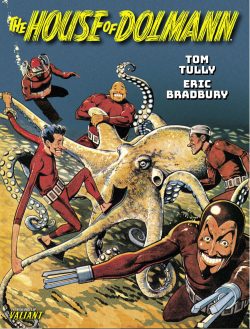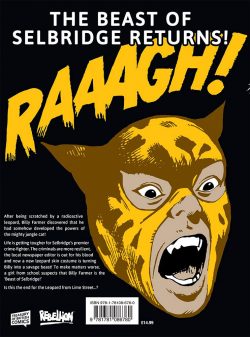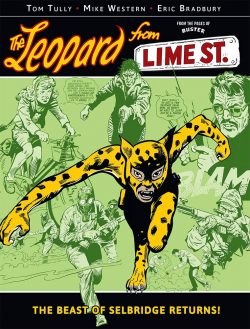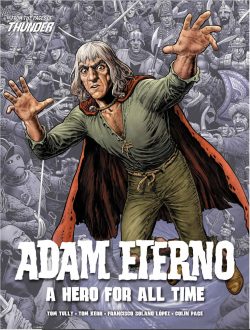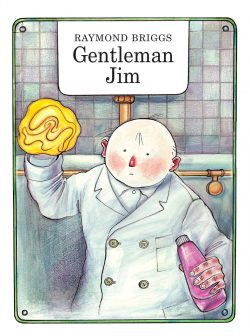
By Jamie Smart, with Sammy Borras (David Fickling Books)
ISBN: 978-1-78845-285-4 (Digest HB)
Win’s Christmas Gift Recommendation: Madcap Mega-Meta Magnificence… 10/10
Bunny vs. Monkey has been a staple of The Phoenix since the very first issue in 2012: recounting a madcap vendetta gripping animal arch-enemies set amidst an idyllic arcadia masquerading as more-or-less mundane but critically endangered English woodlands.
Concocted with gleefully gentle mania by cartoonist, comics artist and novelist Jamie Smart (Fish Head Steve!; Looshkin; Flember), his trendsetting, mind-bending yarns have been wisely retooled as graphic albums available in remastered, double-length digest editions such as this one.
All the tail-biting tension and animal argy-bargy began yonks ago after an obnoxious little beast plopped down in the wake of a disastrous British space shot. Crashlanding in Crinkle Woods – scant miles from his launch site – lab animal Monkey believed himself the rightful owner of a strange new world, despite all efforts from reasonable, sensible, genteel, contemplative forest resident Bunny to dissuade him. For all his patience, propriety and good breeding, the laid-back lepine just could not contain the incorrigible idiot ape, who was – and is – a rude, noise-loving, chaos-creating loutish troublemaker…
Problems are exacerbated by the other unconventional Crinkle creatures, particularly a skunk called Skunky who has a mad scientist’s attitude to life and a propensity to build extremely dangerous robots and super-weapons…
Here – with artistic assistance from design deputy Sammy Borras – the war of nerves and mega-ordnances appears to be over. The unruly assortment of odd critters cluttering up the bucolic paradise had finally picked sides and the battles ended. They even seemingly forgot the ever-encroaching Hyoomanz…
Following a double-page pin-up of our odd and ever-expanding cast, this magnificent hardback archive of insanity opens in the traditional manner: divided into seasonal outbursts, and starting slowly with a querulous teaser tale as the cold retreats and Spring begins in ‘D.I.Whyyyy?’
As the animals all gather to help Bunny repair his much-abused house, universal innocents Weenie squirrel and Pig Piggerton are more keen than skilled, with no idea that cheese is not a suitable substitute for wallpaper paste, plaster or cement…
Despite the subsequent collapse, times are good and very peaceful since the anarchic ape went away and Ai acts quickly to keep it that way when Bunny feels nostalgic for the old days. Sadly, somebody’s listening and brings in a ‘Makeshift Monkey!’ – until the real deal returns in ‘The Little Monkey Who Cried…’
It isn’t long before Skunky is back too and everyone’s fleeing for their lives from deadly underground tentacles, but life quickly resumes its old pattern until obsolescence rears its ugly head and cyborg gator Metal Steve is pronounced ‘Out of Warranty’ and left to wither on Skunky’s scrapheap…
Back and still bad, Monkey briefly inflicts himself on Bunny and wrecks the joint again in ‘The Housemate’ after which the mercurial monochrome megamind constructs a replacement for the gone gator and triggers a ‘Robot Rampage’ when infinitely superior mechanoid Metal E.V.E. decides to lay down her law…
Falling foul of another near-lethal prank the silly simian is scientifically resurrected and evolved in ‘Curse of the Monkey’ only to trip on his own incompetence and barely escape a fishy final fate in ‘Toilet Run!’
A close call with humans in ‘Bunny vs Monkey Jellybeans!’ precedes Weenie and Pig going on ‘A Dangerous Voyage’ as pirates, before Monkey endures his own Fantastic Voyage. Skunky is “The Most Brilliant Animal in the Woods” and convinces his erstwhile ally to shrink down and explore the inner cerebellum of brain-battered, bewildered former stuntman Action Beaver in search of ‘The Lost Memory’ of a misplaced ultimate weapon, which is what probably inspires him to make his own after entering a competition and prematurely unleashing his ‘Winning Entry’…
Metal E.V.E. is forming her own plans but they have to wait a bit as she’s ‘Keepin’ Busy’ with some domestic chores in Skunky’s lab, but’s not long until Summer begins and the woods are imperilled by subterranean invasion from new menace ‘Roland T. Mole’…
Hijinks in parallel dimensions herald the arrival of doomsayer ‘Skunky?’ whilst the forgotten stuntman stumbles onto his ancestral homeland in ‘Beaverville’ with catastrophic consequences even as Monkey creates unexpected carnage but precious little terror with super-cute kaiju ‘Rofl Axolotl’ before being painfully reminded how dangerous the woods can be in ‘So Beautiful’…
After a brief and deceptive flirtation with ‘The Dark Arts’ the hairy halfwit returns to science and creates little golden minions, but his ‘Gloobs’ prove too smart for servitude, so he instead embraces high fashion in ‘C’est Chic!’ Utterly uncaring, Weenie and Pig go about their business until a ‘A New Friend’ almost breaks up the partnership. The swiftly-developing relationship of ‘Weenie and Winnie’ seems set to end the good old days but another robotic invasion sets the world to rights in ‘Just Checking’…
A reality-altering beast threatens in ‘Wishful Thinking’ and the entire woods go all French just as aliens invade in ‘L’Honk Honk’ before Monkey and Skunky explore artisanal dining in ‘Eat Up!’ with appalling consequences for their customers, after which Ai and Monkey discover uncanny ‘Night Lights’ in the deep dark woods…
The eventful season concludes as Metal E.V.E. gets ahead by installing some crucial ‘Upgrades’ and inadvertently making contact with an unsuspected predecessor just as Autumn opens with ‘Bumblesnatch’ as the pig and squirrel enjoy some super-powers-inducing chewing gum and Crinkle Woods is catapulted into a different kind of chaos when broached by pet dog ‘Fluffy’…
When ‘The Summoning’ invokes some pretty indifferent forest gods, Skunky lodges with over-accommodating Bunny who is soon sucked into unwanted adventure ‘Down Below’ and unearths E.V.E.’s brave new world and hopeless old ally as Metal Steve runs amok with nano-bots and spawns the unlikely armageddon beast ‘Pig-Kira!’
Once that menace vanishes into vapour, the mostly organic animals unite and formulate ‘Some Kind of Plan’ to fight E.V.E. – except ‘Nurse Monkey’ who’s keen to explore other lifestyles – until reenlisting in ‘Roll Up! Roll Up!’ with a barmy spinning machine which has no chance of easing their plight but will probably end their lives before she does…
The crusade pauses for Weenie’s birthday and the hunt for ‘The Best Present in the World’ but starts again when E.V.E. crashes the party with ‘Something to Say’ about the “rise of the machines” and end of all flesh…
Skunky’s obvious response is another monster, but giant mecha-hedgehog ‘Thunderball!’ is easily overcome, and as so-distractable Monkey goes wild among the fallen leaves in ‘Leaf it Alone’, the machine rise begins in ‘Nahhhhh!’ Sadly, Metal E.V.E. makes a big mistake then, spilling Monkey’s drink and kicking the conflict to an unprecedented new level…
Pausing for Weenie, Pig, Ai and Bunny to share some ‘Scary Stories’ around a night time campfire, the crisis enters a new phase when the ghost of local legend Fantastic Le Fox, manifests, even as the manic simian is captured and transformed into E.V.E.’s ‘Metal Monkey’…
Le Fox is ‘An Old Friend’ resolved to help the animals survive, and his strategic advice is welcome, but the turning point comes in ‘Clash of the Robots’ as Metal Monkey and Steve duel, even as their mecha-mistress takes charge, unleashing DNA-altering microbots that put the fleshy freedom fighters to flight in ‘Uh-Oh-Nano!’
Winter sets in and hostilities suddenly cease as all concerned succumb to the temptation of chucking ‘Snowballs’ after which the end gets nigher in a wave of robotic attacks triggered by ‘Metal Mania’. Yet again everything pauses as Christmas gives the heroes a moment to unwrap ‘Presents’ but, drenched in seasonal spirit, ‘An Unlikely Hero’ dares to bring the message of the moment right to the robot queen: unwittingly changing the course of history in the woods, and leaving only some ‘Tidying Up’ to restore everything to what passes for normal in the sylvan glade…
The animal anarchy might have ended for now there’s more secrets to share thanks to detailed instructions on ‘How to Draw Metal Steve’ and ‘How to Draw Metal E.V.E.’ to wind down from all that angsty furore…
The zany zenith of absurdist adventure, Bunny vs Monkey is weird wit, brilliant invention, potent sentiment and superb cartooning all crammed into one eccentrically excellent package. These tails never fail to deliver jubilant joy for grown-ups of every vintage, even those who claim they only get it for their kids. This is the kind of comic parents beg kids to read to them. Shouldn’t that be you?
Text and illustrations © Jamie Smart 2022. All rights reserved.









